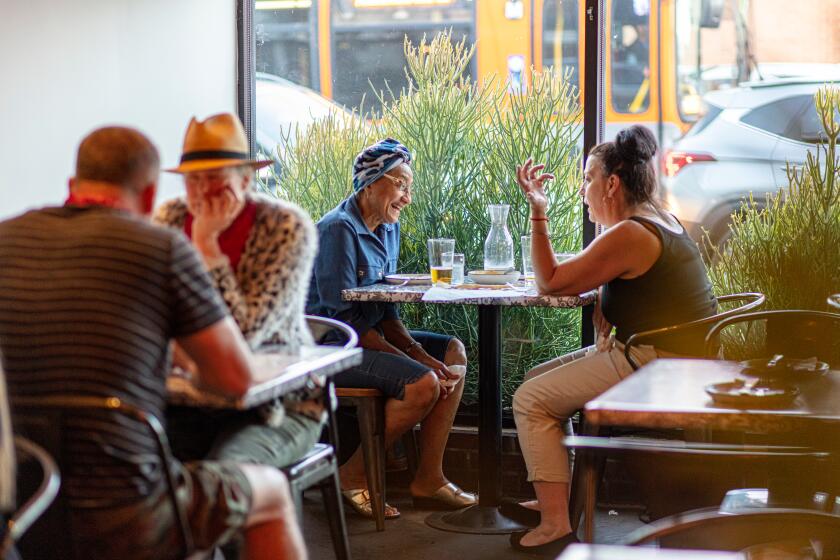Essence of Excellence
Seated at the counter, we watch, fascinated, as sushi master Masa Takayama uses the sharp edge of an abalone shell to scrape flesh from the bones of a bluefin tuna. This is merely a 2-foot-long section of the carcass: The entire fish weighed about 350 pounds, he tells me, pacing out its length. Behind him, cherry blossoms jut from a 400-year-old vase in a shallow pool, the backdrop to this extraordinary performance.
I’ve never seen Takayama do this before, but then every time I’ve eaten at Ginza Sushi-Ko, he has come up with something new and startling. He piles the moist red tuna in a small, footed glass bowl and adds a generous scoop of glistening gray-green beluga caviar. An assistant adds glowing hardwood coals to a handmade glazed raku hibachi. Takayama toasts dominoes of bread on the hibachi, turning them with his chopsticks. He sets the toast and the toro tartare before us. We scoop a little of the toro and the caviar on each toast. The warm toast, the fat-rich raw tuna and the cool, salty caviar are deliriously good together. If the meal ended right here, I would be satisfied.
Next he removes a long flap of Japanese hamo fish from a glass box, which holds the night’s ingredients. Slapping the fish onto the thick cutting board of gingko wood, he picks up a hand-forged Japanese knife. I hear the soft, percussive crack, crack, crack as he cuts through the bone--but not the skin. A server sets an earthenware chafing dish with boiling broth in front of us. Passing us a plate of the inch-wide sections of the fish, he instructs us to swish each piece through the seaweed-scented dashi until it turns opaque. The hamo in our chopsticks curls and opens to form a chrysanthemum-shaped blossom.
Whenever I make reservations at Ginza Sushi-Ko, I look forward to the moment when I dip my head under the door-cloth, slide open the wooden door and take my place at the nine-seat counter. I love the feel of the blond maple counter that’s sanded satiny smooth each morning, and the astonishing flowers.
In an uncertain world, I’m soothed by the calm assurance and easy presence of the chef behind the counter. I look for the fat straw coils of the basket that holds the rice. I check for the hibachi, Takayama’s array of knives from a craftsman in Kyoto, his fine-toothed grater and the fresh wasabi root. A slab of ice keeps the contents of the glass box cool: I can make out the curl of an octopus tentacle, abalone in the shell, ika, or squid, clams in the shell, and various cuts of silver-skinned fish neatly stacked.
The Beverly Hills sushi restaurant is notorious for its prices, which begin at $300 per person and go higher during fugu (blowfish) season, which starts in January. That’s without tax, tip or alcohol, making it slightly more costly than even three-star Michelin chef Alain Ducasse’s eponymous New York restaurant. But Takayama serves at most 10 or 12 people a night, and often eight to 10. Part of what you’re paying for is exclusivity and the intimacy of the experience. There are no menus--and no prices listed. You simply sit down and Takayama feeds you until you tell him you’re sated. He notes the way you eat, intuitively. Not everyone gets exactly the same dishes on any given night. He may remember that this guest loves the ochre uni straight, folded in a cone of crisped nori (seaweed), or that another would be thrilled by a menu that’s mostly toro in different guises.
Yet for all that, there’s nothing pretentious about this restaurant. It has the understated luxury and ease of Japan’s traditional guest houses. Ginza Sushi-Ko is hugely expensive, but more important, it delivers an experience hard to replicate in the best sushi restaurants in Japan. I’d eat here once a week if I could afford it. I know people who are not wealthy, yet they save up to come once a year.
Perfection is almost impossible in a restaurant. But Takayama somehow achieves it, perhaps because of Ginza’s unique format, where every element is under his eye and control. Most of his seafood arrives every couple of days on a flight from Japan. Uni, though, is found off the coast near Santa Barbara, and the fresh wasabi root is grown in Oregon. He tends to favor foie gras over monkfish liver. Cut thinly to the size of a 50-cent piece, the foie gras floats in the simmering broth until you pluck it out with your chopsticks, and the fat floods your tongue. The taste is pure, a revelation to anyone who has only tasted duck liver seared or in a heavily reduced sauce.
On my last visit, he cut sashimi of rock fish and laid the translucent slices on a sheet of what turned out to be dried kelp. “Only a few minutes,” he explained, “just enough to pick up the scent of the sea.” Arranging the rock fish on gorgeous handmade plates speckled like a quail’s egg, he showers them with sea salt, then scatters the dish with pink shiso blossoms, dark violet sprouts, daikon leaf cut as fine as a thread, and yellow flower petals. The final touch is edible gold leaf flakes that settle and quiver on the dish like butterflies. It is so beautiful I want to cry.
“Roll up the fish,” he urges, “and dip it in the sauce.” It’s a dark soy broth thick with grated daikon. The taste is a densely woven fabric of cool, salt, sea and green that can’t be pulled apart.
Not everything is traditional at Ginza Sushi-Ko. Takayama has been experimenting recently with risotto. Last time he set down what looked like three spoons of soft scrambled eggs. I sniffed it and caught the iodine of uni. I took a bite: heavenly. Al dente rice suspended in sea urchin roe. What gives it that incredibly creamy texture? Cod sperm sac. That’s a first for me.
Sometimes tastes are small, yet incredibly intense. I’m thinking of a thimble-sized bowl with a few bites of slippery-looking stuff in an almost fluorescent orange sauce. Takayama isn’t saying what it is until we try it. Sweet and pungent, it delivers a powerful punch. This delicacy is raw, sweet shrimp marinated in shrimp innards. It’s like nothing I’ve ever tasted.
The sushi usually comes at the end, in pairs, until you’ve had enough. Nigiri-zushi, ovals of rice with a topping, are small enough to constitute a single bite. There’s toro, which is, of course, superb, and pearly ika with yuzu grated over and a sprinkling of sea salt, the sliver of octopus tentacle (with the suckers), or delicious sweet clam, which has just a two-month season. I love the assertive brininess of red clam, too, the silvery-skinned Japanese herring and glistening fresh uni sashed in nori.
Sometimes he’ll cut thin slices from a slab of Kobe, the heavily marbled Japanese beef, and grill them briefly on the hibachi, just enough to melt the fat and bring out the flavor of the beef before he drapes them over rice. A few weeks ago, he took a fist-sized matsutake, the fabulously expensive forest mushroom, and sliced it lengthwise so that it looked like a section of a Greek column. That went on the grill, too, beneath parchment paper moistened with sake to keep the mushroom from drying out, bringing out its incredibly delicate perfume. It made a breathtaking piece of sushi.
Finished, I wipe my hands on a hot towel and pick up a cup of soothing green tea. The meal always ends on a graceful note, with some luscious perfumed melon or a pink grapefruit ice that’s halfway between the fruit itself and a granita.
It’s not often that you leave a restaurant more alert than when you entered. The experience at Ginza Sushi-Ko is very different from that at other establishments where food arrives teased and fussed over, already plated. Seated at the sushi counter across from Takayama, everything interests me and I feel a profound connection with what I’m eating. I find myself thinking, “So this is the taste of sweet shrimp! So this is the taste of abalone!” The aesthetic is a departure from Western cuisine, which is more about the thrill of disguise and transformation. Here each element in the meal is allowed to express its essence.
Ginza Sushi-Ko
Two Rodeo
218 N. Rodeo Drive
Beverly Hills
(310) 247-8939
Cuisine: Japanese
Rating: ****
AMBIENCE: Small, discreet sushi restaurant with counter that seats nine and a couple of tables.
SERVICE: Unobtrusive and intuitive.
BEST DISHES: No menu, the chef chooses for you: toro tartare with caviar, hamo fish, foie gras in dashi, extraordinary uni (sea urchin), sweet shrimp and sushi. $300, more in fugu season. No corkage.
DRINK PICKS: The house sake, or bring a fine Champagne.
FACTS: Dinner by reservation Monday through Saturday. Valet parking. Rating is based on food, service and ambience, with price taken into account in relation to quality. ****: Outstanding on every level. ***: Excellent. **: Very good. *: Good. No star: Poor to satisfactory.
More to Read
Eat your way across L.A.
Get our weekly Tasting Notes newsletter for reviews, news and more.
You may occasionally receive promotional content from the Los Angeles Times.






